Trucker Access › Forums › Diesel News › Will Side-Underride Guards be Required for Trailers in the U.S.? – Equipment
- This topic has 0 replies, 1 voice, and was last updated 9 months, 3 weeks ago by
 EazyRiDer66.
EazyRiDer66.
-
AuthorPosts
-
June 13, 2024 at 2:45 pm #25414
 EazyRiDer66Keymaster
EazyRiDer66Keymaster

If commercial vehicle electrification and stiffer emissions regs aren’t enough to keep us awake at night, we may soon have another hurdle to contend with. The National Highway Traffic Safety Administration is looking at mandating side impact guards for tractor-trailers — specifically semi-trailers.
Who could forget the debates over rear-underride guards? If a side underride mandate is implemented, it could be even more complicated.
There will be concerns over high-centering events and the need to ensure guard designs are compatible with railroad crossings and docking facilities. Weight, too, could be a concern, with early estimates on guard weights ranging from 400-800 pounds.
The American Trucking Associations’ Technology & Maintenance Council hosted a study group session at its annual meeting in March. It was an information session followed by a wide-ranging Q&A intended to inform fleets what might be in the works rather than to raise alarm bells — though it certainly did that.
Side Underride: Two Problems, Two Solutions
Robert Martineau, CEO of Montreal, Quebec-based side-guard manufacturer AirFlow Deflector, kicked off the discussion. He described the challenges facing regulators in defining the types of guards needed to improve safety for vulnerable road users.
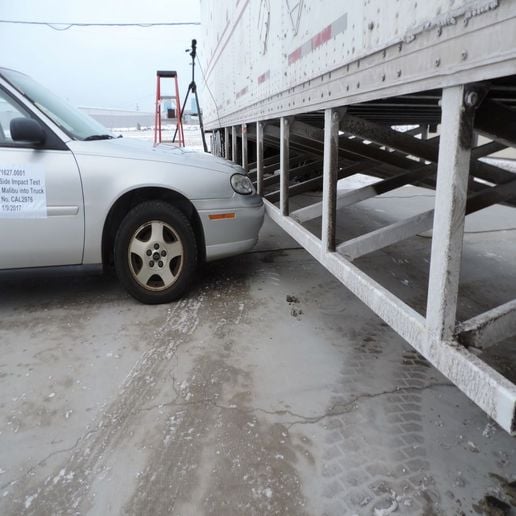
Side-underride guard built to the Volpe standard must fill the space between the front wheel or battery box and the rear wheels, while being capable of adsorbing an impact force of 450 pounds.
“We’re going to see a lot of dialogue between state and federal officials, and cities and municipalities, as we have to recognize the environment of sideguards is evolving,” he said. “There’s a difference between city trucks and tractor-trailers, and single-use trucks such as refuse and dump trucks.
“The objective of side-guards, in one instance, is to protect or to prevent injury or death of pedestrians, cyclists, motorcyclists in urban settings. On the other hand, [it’s] to protect the occupants of smaller vehicles in collisions with semi-trailers.”
That’s a tall order, and one that won’t be solved with a one-size-fits-all mandate — if we see a mandate at all.
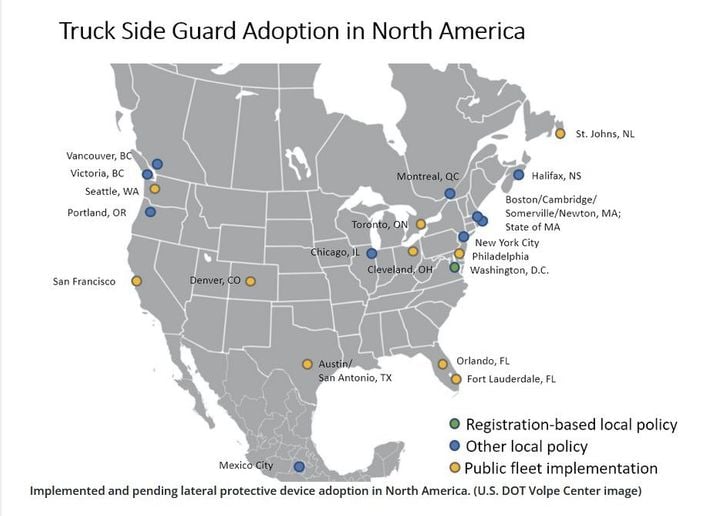
There has been growing lateral protective device adoption in the United States at the local and private-sector levels, including dozens of private fleets and municipal or city-contracted fleets in over a dozen cities from coast to coast.
Cities Adopting Side-Underride Guard Standards
NHTSA seems to be focusing on highway trailers for the moment, but other smaller trucks are still within its mandate.
On top of that, various cities are implementing requirements for side-underride protection for certain vehicles under their jurisdiction, such as refuse trucks.
“The movement to require side-underride protection began some years ago [1979] in Asia, followed by Europe [1986] and Latin America [2009], among others,” Martineau said.
“In the United States, it really got under way in 2015 when New York City and Boston developed ordinances requiring side guards. That’s still evolving as to who’s affected, who needs to put guards on, and so on, but we also see voluntary compliance in many instances simply because it’s the right thing to do.”
How Many Lives Could Be Saved by Side-Underride Guards?
One of the key questions in determining whether or not to require side underride protection is the potential for saving lives.
Not to be overly cynical, but the Department of Transportation places a dollar value on lives lost when doing the cost/benefit calculations. The larger the death toll, the easier it is to justify.
But there’s disagreement on just how many lives are currently lose due to these crashes.
Initial research released by NHTSA estimated that 17.2 lives would be saved and 69 serious injuries would be prevented each year once all trailers are equipped with side underride guards.
During the TMC study group session, ATA Director of Safety and Technology Policy Kevin Grove said the annual fatality tally was substantially higher.
“While doing their research, NHTSA found that side-underride crashes were under-reported,” he said. “They found there were approximately 79 fatalities per year associated with underride crashes involving for motor vehicles.
“They did this by doing a lot of really good detective work, digging into the fatal accident crash database, looking into police reports trying to really understand what was a likely [side underride] scenario.”
The Insurance Institute for Highway Safety pegged the number even higher.
Using an alternative method, IIHS senior research engineer, Matthew Brumbelow, projected that a side underride guard mandate could prevent 159-217 passenger vehicle occupant fatalities per year, depending on whether it required protection forward of the rear axle or along the full length of the trailer, the IIHS notes on its website.
So… 17.2 lives? Or 79 lives? Or 217 lives?
Those numbers could have quite an impact on the cost/benefit calculations.
What’s the Best Side-Impact Guard?
It’s impossible to state definitively at this point which is a suitable side impact guard, because there are no enshrined standards for such guards.
The Department of Transportation’s Volpe Center is probably the definitive resource at this point. It has tested a number of guards used on city trucks and at least one side-underride guard for semi-trailers.
Volpe has also established a standard for side-underride guards for city trucks that has been widely adopted and referenced in many city ordinances related to underride protection.
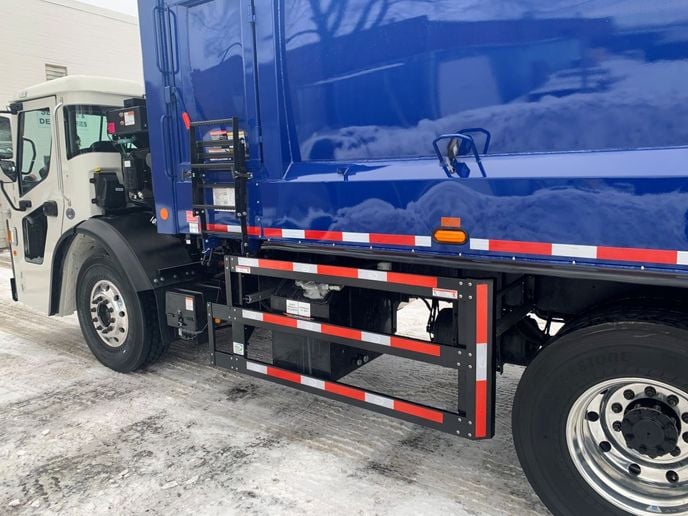
NHTSA is mulling a mandate on semi-trailer side-underride guards, but many cities and municipalities require companies bidding contracts to use trucks with side-guards.
The purpose of side-underride guard on a city truck is to prevent pedestrians and cyclists from being run over by the truck’s rear wheels. Volpe research shows that such incidents are often the result of some initial impact with the side of the truck, after which the pedestrian/cyclist falls to the ground, often in the path of the wheels.
Briefly, the Volpe Best Practice states the guard should be more than 13.8 inches about the ground and cover an area extending from 4 inches behind the front wheel or fuel tank, to no further than 11.8 inches ahead of the rear wheel.
The guard itself can be metal bars or tubing, slats of suitable strength, or solid panels such as we see in tractor side skirts. Accessory components such as toolboxes, etc., can also qualify provided they meet the dimensional requirements.
As for the strength requirement, basically it must be capable of withstanding 450 pounds (2 kilonewtons) of force applied perpendicularly to any part of its surface by the center of a flat, circular plate of diameter no greater than 8.7 inches, and deflects no more than a prescribed distance.
This type of guard would apply to Class 3 and above vehicles, with a gross vehicle weight rating of 10,000 pounds and higher.
Martineau explained in an interview following the TMC session that until Volpe developed a standard and tested it, there were a variety of side underride guards on the market, but they weren’t necessarily up to snuff.
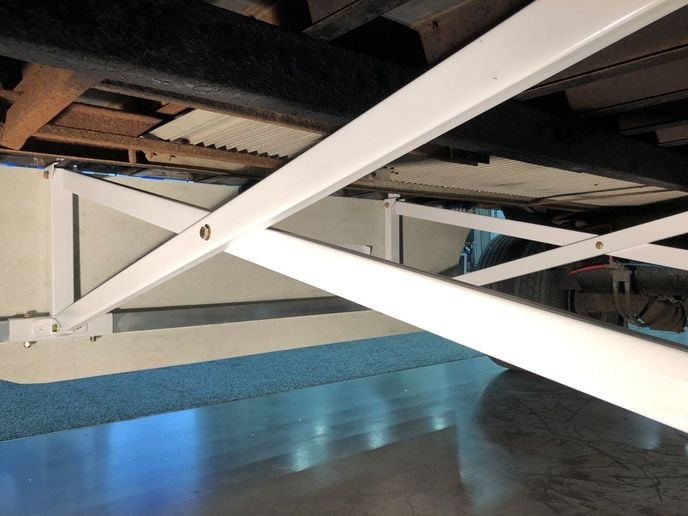
Underside detail of the AngelWing side-underride guard by AirFlow Deflector. It was the only guard of its kind on the market when NHTSA was gathering cost, weight and performance data on side-underride guards.
“North America currently has the most rigorous standard in the world for side-underride protection,” he said from his office in Montreal.
“In Europe, for example, their side impact standard is just 220 pounds. You can see by examining the devices they use compared to a Volpe design, we are considerably stronger.”
He added that the devices are not required to be “certified” to any particular engineering standard (unlike rear-underride guards), but the manufacturer should attest in writing that their guard meet Volpe’s standards.
“This is a conundrum for enforcement,” he said. “By not having a certification with the device, it’s harder to tell which products meet the standard unless the operator can show the device was designed and built to the Volpe standard.”
Having a recommended standard but not requiring certification is a bit messy, Martineau admits, but he insists it’s working out well so far.
[embed]https://www.youtube.com/watch?v=FREj0hKJOFg[/embed]
Side-Underride Guards for Semi-Trailers
Perhaps surprisingly, Volpe notes on its website that some trailer side-skirts may also protect vulnerable road users in side-impact collisions.
“A number of side skirt manufacturers have already verified that their panels can meet lateral protective device structural requirements with few or no modifications.
“A dual-purpose lateral protective device/side-skirt may provide both vulnerable road user safety and fuel return on investment to the owner.”
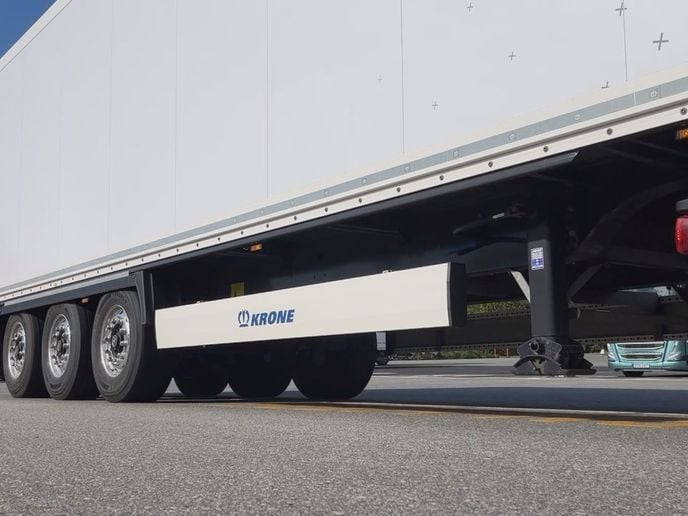
Side-underride guard have been mandatory in Europe for all trucks, trailers and semi-trailers since 1986. Performance standards there are lighter than what might be proposed in the U.S.
But when it comes to keeping cars out from under trailers, side-skirts are of little use.
“In this case of pedestrians, cyclists, motorcyclists, a side-impact guard has to be able to absorb 450 pounds of force, but when a vehicle [the Chevy Malibu is the standard test vehicle) strikes a semi-trailer at right-angles going 45 mph, the side-underride guard needs to absorb nearly 69,000 pounds of force to keep the passenger compartment from going under the trailer, Martineau said during the TMC panel, ending his presentation on that sobering note.
Clearly a device capable of absorbing 69,000 pound in the form of a careening automobile will require significant engineering resources and be of very robust construction.
At the TMC podium, ATA’s Grove expressed concern about the cost and the weight of such a device, as well as the potential for operational problems.
“NHTSA estimates the equipment costs based on currently available guard designs when fitted to all newly manufactured trailers would be about $800 million a year,” he said.
“That doesn’t include additional annual fuel costs of $200 million to $400 million that would be incurred due to the additional weight of the underride guard-equipped trailers,” Grove added.
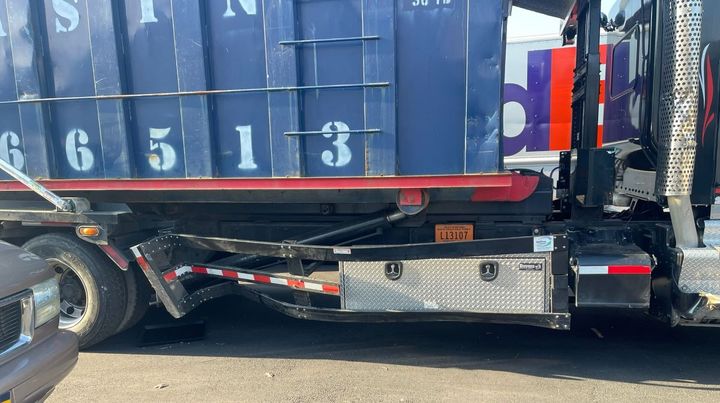
This side-underride guard system did its job, preventing serious injury to a pedestrian or cyclist.
“NHTSA did their own calculation based on available information and came up with a negative annual cost of about $1.2 billion if side-underride guards were to be mandated on all newly manufacturer trailers,” he told the audience.
HDT reported last year that those estimates do not include any additional costs associated with factors such as reinforcing trailers to accommodate the guards, changes to trailer loading patterns, and other factors.
Those estimates were based on NHTSA’s analysis of the only side underride guard system available at the time: the AngelWing guard manufactured by AirFlow Deflector.
Grove also outlined additional concerns ATA has expressed to the NHTSA committee looking at underride guards, including high-centering events and making sure designs are compatible with railroad crossings and docking facilities.
ATA’s position is that it would be difficult to come up with a one-size-fits-all design for every type of trailer.
And as was the case (and still is) with rear-underride guards, ATA has concerns about maintenance and repair requirements, annual inspections, driver responsibilities, etc.
Grove said NHTSA should also consider crash avoidance or mitigation technologies before deciding to require such a massive and expensive rulemaking.
“There should be some conversations about the role of crash avoidance in preventing these incidents in the first place and how that technology can factor into the bigger picture of reducing fatal under-ride crashes,” he said.
-
AuthorPosts
- You must be logged in to reply to this topic.